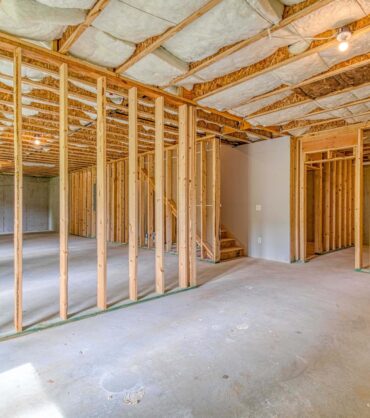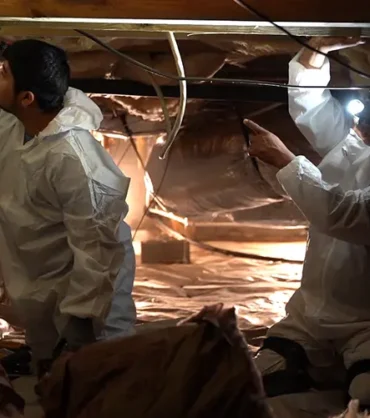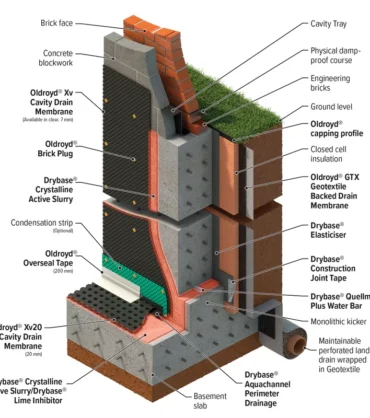Have you ever walked into a basement and felt that unmistakable damp chill? It’s more than just a feeling; it’s a warning sign. We understand that your home or building is your most important investment. Protecting it from hidden threats is our top priority.
Water is a powerful force. Over time, it can quietly compromise the very base of your structure. Ignoring this can lead to serious problems like cracked walls and uneven floors. These issues are not just expensive to fix; they threaten the safety of everyone inside.
That’s why we’ve created this guide. We want to walk you through the essential steps for keeping your property safe and dry. Our proven methods create a powerful barrier against moisture. This protection ensures your building remains strong for decades.
We believe everyone deserves peace of mind. Our experts are ready to help you 24/7. Call us anytime at 1-833 888 2533 for a free, no-obligation consultation. Let’s protect what matters most, together.
Key Takeaways
- Proper below-grade protection is vital for a building’s long-term strength and safety.
- Ignoring moisture issues can lead to severe structural damage and costly repairs.
- Effective solutions create a durable barrier that keeps lower levels completely dry.
- This guide provides practical insights into the complete process from start to finish.
- Our team offers expert guidance and is available around the clock for your questions.
Understanding the Importance of Foundation Waterproofing
Moisture protection for below-grade structures isn’t just an option—it’s essential for lasting durability. We’ve seen how proper planning during the building phase creates structures that stand strong for generations.

Structural Integrity and Long-Term Protection
Your building’s strength depends on keeping water away from critical components. When moisture seeps in, it can weaken materials over time.
This protection ensures your property maintains its value and safety. Proper barriers prevent issues like mold and material deterioration.
| Protection Method | Short-Term Benefits | Long-Term Advantages | Cost Comparison |
|---|---|---|---|
| Quality Moisture Barriers | Immediate dryness | Decades of protection | Lower than future repairs |
| Proper Drainage Systems | Reduced water pressure | Prevents structural stress | Minimal maintenance needed |
| Complete Sealing | No initial leaks | Consistent performance | One-time investment |
Cost Benefits and Preventing Major Repairs
Investing in quality solutions during construction saves significant money later. Addressing water infiltration early prevents expensive emergency fixes.
We help clients understand that proper waterproofing is actually cost-effective. It’s much more affordable than dealing with structural damage down the line.
Your peace of mind is worth the initial investment. Let us show you how smart planning today prevents headaches tomorrow.
Identifying Moisture Problems Around Your Foundation
Many homeowners miss the subtle clues that their foundation walls are battling moisture. Recognizing these early signs is crucial for preventing minor issues from escalating into major structural concerns.
Common Signs and Early Indicators
Your home gives clear signals. Look for damp or wet spots on walls and floors. A musty odor or visible mold growth are strong indicators of excess water.
Peeling paint, warped wood, and swollen door frames also signal trouble. That white, powdery substance called efflorescence on a foundation wall is a key sign of moisture moving through the concrete.

How We Inspect for Cracks and Moisture Intrusion
Our process is thorough. We examine every wall surface for cracks and gaps. We pay close attention to the cove joint where the wall meets the floor.
We also check areas around pipes and utilities for potential leaks. Our team uses professional techniques to find hidden water intrusion patterns.
We assess the severity of any cracks or leaks we find. This helps us plan the most effective repair strategy for your specific situation.
| Warning Sign | What It Often Means | Potential Risk Level |
|---|---|---|
| Damp Spots on Walls | Active seepage or condensation | Medium |
| Efflorescence (White Powder) | Capillary action pulling moisture through | High |
| Musty Odors | Possible mold growth hidden from view | Medium to High |
| Visible Cracks | Direct path for water entry | High |
Planning Effective Waterproofing Methods
The success of any below-grade protection system depends on accurately identifying the specific water challenges present. We begin each project with a detailed assessment of your site’s unique conditions.
Evaluating Hydrostatic Pressure and Capillary Action
Hydrostatic pressure occurs when groundwater builds up against your walls. This constant water pressure can force moisture through even tiny openings.
Capillary action works differently. Water wicks through porous materials like concrete through microscopic channels. Understanding both forces helps us create targeted solutions.
| Water Force | How It Works | Common Signs | Required Protection Level |
|---|---|---|---|
| Hydrostatic Pressure | Groundwater pushes against walls with significant force | Active leaks, standing water | Full waterproofing membrane |
| Capillary Action | Water moves through porous materials via absorption | Dampness, efflorescence | Vapor-resistant coating |

Choosing Between Dampproofing and Full Waterproofing
Dampproofing resists moisture vapor in normal conditions. It’s suitable for areas without significant water pressure. Full waterproofing prevents water infiltration under hydrostatic pressure.
We recommend exterior waterproofing for sites with high water tables. This approach creates a protective layer between your structure and water sources. The membrane coating actually benefits from external pressure, creating a tighter seal.
Our team evaluates your specific conditions to determine the right approach. This ensures your protection system matches your actual needs.
Foundation Waterproofing: Our Proven Techniques
Our team employs a multi-layered strategy that addresses both surface water and groundwater issues through proven construction techniques. This comprehensive approach ensures complete protection against moisture intrusion.
Step-by-Step Application Strategies
We begin with proper backfilling using at least 16 inches of granular material adjacent to your structure’s walls. This creates an effective drainage path that channels moisture away from critical areas.
Perforated footing drains installed around the perimeter serve as a crucial step in relieving pressure buildup. These systems work continuously to redirect groundwater before it can compromise your building’s integrity.

Addressing Hydrostatic Pressure and Soil Conditions
We carefully manage the soil around your property to prevent water accumulation. Proper sloping ensures rapid drainage away from your walls, typically dropping about 10 feet from the structure.
Our methods adapt to specific site conditions, whether dealing with moisture-retaining clay or fast-draining sandy soils. Each layer of protection builds upon the previous one, creating a seamless barrier against water infiltration.
Professional-grade membranes and vapor barriers provide additional defense against capillary action. This complete system manages both external water pressure and internal moisture movement effectively.
Installation Best Practices and Tools
Professional installation begins with selecting the proper equipment and materials. We carefully choose tools that ensure perfect application every time. The right approach makes your protection system last for decades.
Essential Tools and Product Choices
Our toolkit includes paint rollers, smoothing rollers, and specialty trowels. These tools help us apply materials evenly across your concrete surfaces. We select products based on your specific conditions and temperature requirements.
For colder climates, we use low-temperature membranes that install properly even at 14°F. All materials must condition to at least 50°F before application. This ensures optimal performance of the protective layer.
Substrate Preparation and Membrane Application Tips
Surface preparation is the most critical step in our process. We ensure your poured concrete is smooth, clean, and completely dry. Any debris or moisture can compromise the membrane adhesion.
We repair all cracks before applying the protective coating. Small gaps under ¼ inch get sealed with elastomeric material. Larger openings require concrete repair products for solid substrate restoration.
Our installation guide follows a vertical application method on walls. This technique provides the simplest process with excellent results. We start with reinforcement pieces at corners for added strength.
The membrane strips overlap by at least 3 inches for continuous coverage. This layer extends from above grade down to cover two-thirds of the footing. We mechanically fasten the upper termination and seal it thoroughly.
When backfilling, we use protective materials if soil contains rocks. Sand or special panels prevent damage to the membrane during this final step. This careful approach ensures your exterior walls remain protected.
Maintaining a Dry and Safe Basement
A truly secure lower level depends on proactive maintenance that prevents moisture issues before they start. We focus on keeping your space dry through smart drainage strategies and regular check-ups.
Implementing Drainage Systems and Sump Pump Solutions
Your property’s drainage system serves as the first line defense against water intrusion. Proper grading directs water away foundation effectively. The soil around your structure should slope at least 6 inches over 10 feet.
We install comprehensive drainage solutions including French drains and sump pumps. These system options handle different water pressure situations. They work together to prevent water from reaching your walls.
Routine Inspections and Preventive Maintenance
Regular checks keep your defense strong over time. We recommend testing sump pumps every 3-4 months. Clean gutters twice yearly to maintain their first line protection.
Inspect exterior foundation areas for new cracks twice per year. Check interior walls for moisture signs after heavy rain. This helps catch small leaks before they need repair.
Our team is available 24/7 at 1-833 888 2533 for maintenance questions. We’ll help you maintain optimal conditions that protect your investment.
Contact and Support Information for Waterproofing Projects
When you’re ready to take action on your property’s protection, we make connecting with our team simple and straightforward. Our experts are available to guide you from initial planning to project completion.
We provide multiple ways to reach us for quotes, questions, or emergency support. You can choose the method that works best for your schedule and needs.
Call Support Center 24/7 at 1-833 888 2533
Our support line is open any time, day or night. Whether you’re planning a new construction project or facing an urgent issue, we’re here to help.
You can also email us at info@dmvwp.com for detailed information about our products and services. Don’t waste time wondering about the right solution.
Visit Our Offices in Washington, DC, Rockville, MD, and More
We maintain five convenient offices across the DMV area for in-person consultations. Each location offers the same high-quality expertise.
- Washington, DC: 2315 Wisconsin Ave NW, Washington, DC 20007
- Rockville, MD: 330 N Stonestreet Ave, Unit S, Rockville, MD 20850
- North Bethesda, MD: 5014 Nicholson Ln, Rockville, MD 20852
- Manassas, VA: 10748 Sudley Manor Dr, Manassas, VA 20109
- Ashburn, VA: 44121 Leesburg Pike, Unit 170, Ashburn, VA 20147
Contact us today and let our professionals guide you toward the best solution for your property.
Conclusion
Your building’s long-term strength starts with smart decisions today. This guide has shown you why proper protection is critical for your property’s integrity.
Investing in high-quality foundation waterproofing prevents costly damage from soil water. It secures your building’s value and safety for the future.
Our team provides complete solutions tailored to your specific needs. We manage everything from drainage to membrane application.
Don’t wait for a small leak to become a major problem. Call our experts now at 1-833 888 2533 for a free consultation. Let’s ensure your foundation remains dry and strong for generations.



![[GetPaidStock.com]-680786795b816 [GetPaidStock.com]-680786795b816](https://dmvwp.com/wp-content/uploads/2025/04/GetPaidStock.com-680786795b816-370x418.jpg)

![[GetPaidStock.com]-682c400c87c15 [GetPaidStock.com]-682c400c87c15](https://dmvwp.com/wp-content/uploads/2025/04/GetPaidStock.com-682c400c87c15-370x418.jpg)

![[GetPaidStock.com]-682c413fa898e [GetPaidStock.com]-682c413fa898e](https://dmvwp.com/wp-content/uploads/2025/03/GetPaidStock.com-682c413fa898e-370x418.jpg)